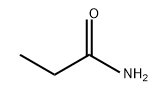A6620612
Propylamine , 98% , 107-10-8
Synonym(s):
1-Aminopropane;Propylamine
CAS NO.:107-10-8
Empirical Formula: C3H9N
Molecular Weight: 59.11
MDL number: MFCD00008205
EINECS: 203-462-3
Update time: 2022-07-08
PRODUCT Properties
| Melting point: | -83 °C (lit.) |
| Boiling point: | 48 °C (lit.) |
| Density | 0.719 g/mL at 25 °C (lit.) |
| vapor density | 2 (vs air) |
| vapor pressure | 4.79 psi ( 20 °C) |
| refractive index | n |
| FEMA | 4237 | PROPYLAMINE |
| Flash point: | −35 °F |
| storage temp. | Store below +30°C. |
| solubility | water: soluble0.4 part(lit.) |
| pka | 10.6(at 20℃) |
| form | Liquid |
| Specific Gravity | 0.7173 |
| color | Clear colorless to pale yellow |
| PH | 12.6 (100g/l, H2O, 20℃) |
| Odor | ammoniacal |
| Odor Type | ammoniacal |
| biological source | human blood |
| Odor Threshold | 0.061ppm |
| explosive limit | 2.1-13.6%(V) |
| Water Solubility | soluble |
| Sensitive | Air Sensitive |
| Merck | 14,7843 |
| JECFA Number | 1580 |
| BRN | 1098243 |
| Exposure limits | No exposure limit has been set. Based on its
similarity to ethylamine in irritation and toxicity, a TLV-TWA of 10 ppm (~24 mg/m3)
should be appropriate.
. |
| Dielectric constant | 3.0(Ambient) |
| Stability: | Stable. Highly flammable. Note low flash point. Readily forms explosive mixtures with air. Incompatible with oxidising agents, strong acids. Store cool. |
| LogP | 0.55 |
| CAS DataBase Reference | 107-10-8(CAS DataBase Reference) |
| NIST Chemistry Reference | 1-Propanamine(107-10-8) |
| EPA Substance Registry System | Propylamine (107-10-8) |
Description and Uses
1-Propylamine is used in chemical analysis and to make other chemicals, used as a solvent in organic synthesis. And it is used as finishing agent of drugs, paints, rubber, fiber, textile and resin. Additionally, it can be used as petroleum additive and preservative.
Safety
| Symbol(GHS) |    GHS02,GHS05,GHS06 |
| Signal word | Danger |
| Hazard statements | H225-H290-H302-H311+H331-H314-H335 |
| Precautionary statements | P210-P280-P301+P330+P331-P303+P361+P353-P304+P340+P311-P305+P351+P338+P310 |
| Hazard Codes | F,C |
| Risk Statements | 11-20/21/22-34-35-52/53 |
| Safety Statements | 26-36/37/39-45-16-7/9-36-61 |
| RIDADR | UN 1277 3/PG 2 |
| WGK Germany | 1 |
| RTECS | UH9100000 |
| F | 34 |
| Autoignition Temperature | 604 °F |
| TSCA | Yes |
| HS Code | 2921 19 99 |
| HazardClass | 3 |
| PackingGroup | II |
| Hazardous Substances Data | 107-10-8(Hazardous Substances Data) |
| Toxicity | LD50 orally in rats: 0.57 g/kg (Smyth) |




